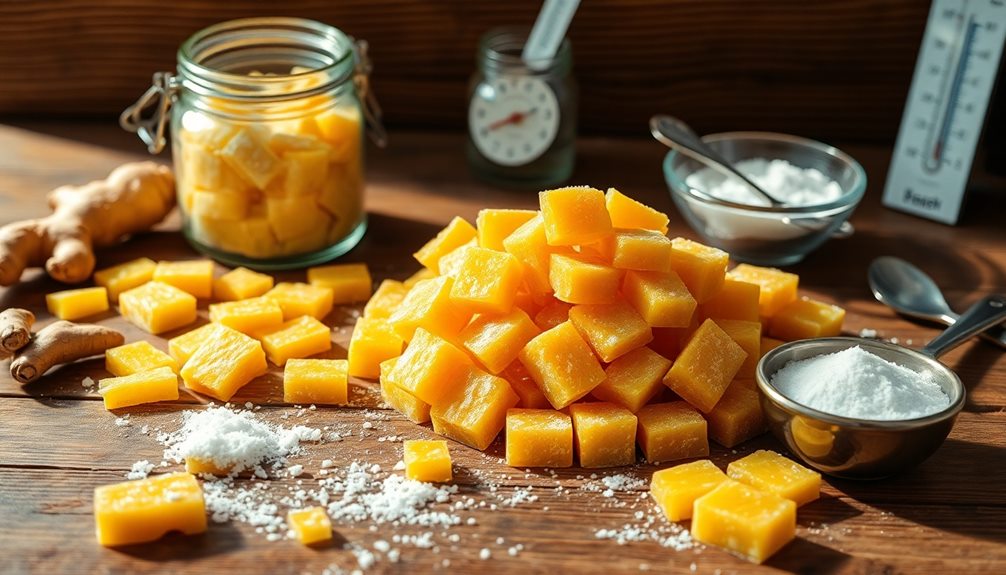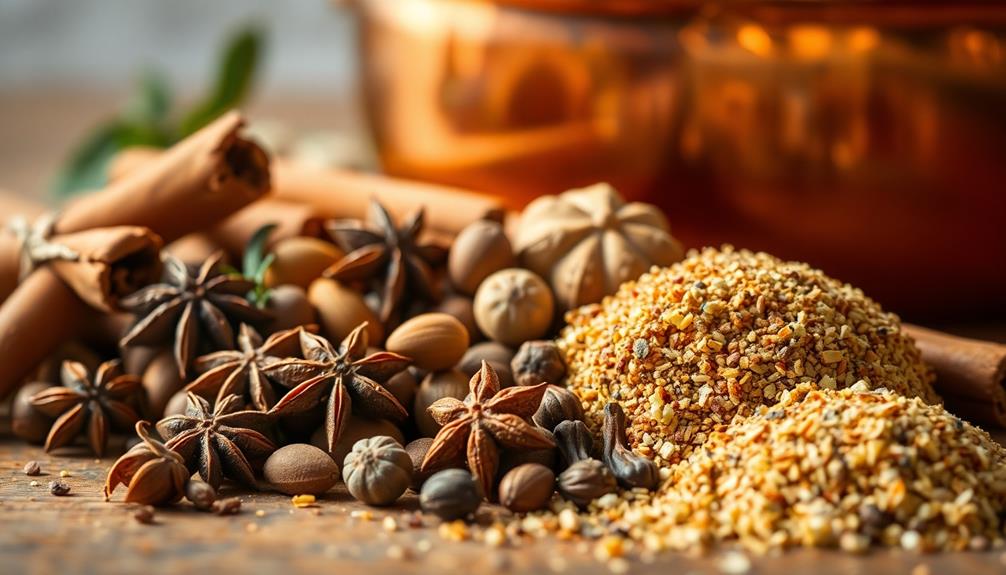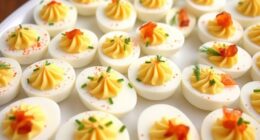To make a flaky pie crust, keep your butter cold and work quickly to prevent it from warming up. Cold butter creates tiny pockets that melt during baking, forming layers and air pockets for flakiness. Handle the dough minimally to avoid overworking and gluten development, which keeps the crust tender. Proper temperature control and gentle mixing are key. Want to learn how to master these tips for perfect layers? Keep exploring the science behind a crisp, flaky crust.
Key Takeaways
- Use cold butter, ideally just out of the fridge, to create small fat layers that melt during baking, forming flaky layers.
- Keep all ingredients cold and handle the dough minimally to prevent gluten development and maintain tenderness.
- Incorporate butter into flour using a pastry cutter or fingers until mixture resembles coarse crumbs with pea-sized butter pieces.
- Add water gradually and mix just until the dough comes together, then chill to hydrate flour and relax gluten for better flakiness.
- Rest the dough in the fridge before baking to allow layers to set and gluten to relax, resulting in a tender, flaky crust.

Making a perfect pie crust might seem simple, but understanding the science behind it can dramatically improve your results. One of the most essential factors is the temperature of your butter. When preparing a flaky crust, you want the butter to be cold—preferably just out of the fridge. Cold butter creates small, solid pieces within the dough, which, during baking, melt and leave behind tiny air pockets. These pockets are what give your crust that desirable flaky texture. If your butter is too warm, it will blend into the flour more completely, resulting in a denser, less flaky crust. Conversely, butter that’s too cold can be difficult to work with and may lead to uneven mixing, so aim for that perfect cold but still workable temperature.
Cold butter creates flaky layers; too warm melts fully, resulting in a dense crust.
Another key element is gluten development. Gluten forms when water interacts with the proteins in flour, creating a network that provides structure. When you mix your dough, minimal gluten development is preferable because too much gluten makes the crust tough and chewy. To keep gluten in check, handle the dough as little as possible and avoid overmixing. Incorporate just enough water to bring the ingredients together, and then stop. This limited gluten formation ensures your crust remains tender and flaky. Using cold ingredients, including water and butter, helps slow down gluten development, which is essential for a light, delicate crust.
The way you combine your ingredients also influences the final texture. Use a pastry cutter or your fingers to cut the cold butter into the flour until the mixture resembles coarse crumbs with some pea-sized pieces of butter remaining. This process creates layers of fat and dough that, when baked, separate and puff up, adding to the flakiness. Once you add water, mix just until the dough comes together, then shape it into a disc, wrap it, and chill it. Resting the dough in the fridge allows the flour to hydrate fully and the gluten to relax, both of which contribute to a tender, flaky crust. Additionally, controlling the temperature throughout the process ensures optimal results since temperature regulation plays a crucial role in achieving perfect layers.
Temperature control during preparation is essential. Keep everything cold, work efficiently, and avoid overhandling. By paying attention to butter temperature and managing gluten development, you set the stage for a pie crust that’s irresistibly flaky and tender. When you understand and control these aspects, making a consistently excellent pie crust becomes much easier. Your baked goods will not only look better but will also deliver a satisfying texture that elevates your entire pie.
Frequently Asked Questions
Can I Use Alternative Flours for a Flaky Pie Crust?
Yes, you can use alternative flours for a flaky pie crust, but keep in mind that flour substitutions affect gluten development, which influences texture. For a tender, flaky crust, choose low-gluten or gluten-free flours like rice or almond flour, and consider adjusting the fat content. Experimenting with different flours may require tweaks in liquid ratios to achieve the right consistency and flakiness.
How Does Humidity Affect Pie Crust Texture?
Humidity impact can make your pie crust either too damp or too dry. When humidity is high, moisture effects cause the dough to become sticky and harder to handle, risking a tough crust. On the other hand, low humidity can dry out your dough, leading to a crumbly texture. To compensate, you might need to adjust your water or fat amounts, ensuring you keep the dough just moist enough for flakiness.
What’s the Best Way to Store Leftover Pie Crust?
You should store leftover pie crust in an airtight container or wrap it tightly with plastic wrap to prevent air exposure. For longer storage, use freezing techniques by wrapping the crust in plastic wrap and then placing it in a resealable freezer bag. Label it with the date, and it can last up to three months. When ready to use, thaw it in the fridge before rolling out.
Does Chilling the Dough Improve Flakiness?
Chilling the dough is like giving it a well-deserved nap—yes, it does improve flakiness. By lowering the dough temperature, you slow gluten development, preventing it from becoming tough. This process also helps fat stay firm, creating those delicate layers. So, before you roll out your crust, pop it in the fridge for at least 30 minutes. Your pie will turn out flakier and more tender, just as you want.
How Does the Fat Type Influence Crust Flakiness?
Using different fats affects crust flakiness because fats with higher melting points, like shortening, create layers that melt during baking, leading to more flakiness. Butter, with a lower melting point, melts quicker, resulting in less distinct layers and a richer flavor. You should also be careful not to overwork the dough, as excessive gluten development makes the crust tougher. Chilling helps control fat melting and gluten development for a perfect flaky crust.
Conclusion
Remember, making a perfect pie crust is like crafting a delicate balance—too much water and it becomes tough, too little and it crumbles. I once watched a novice baker struggle until she gently rested her dough, letting patience do its magic. That moment taught me that mastering pie crust isn’t about rushing but about respecting the science behind it. With practice and care, you’ll create flaky crusts that turn ordinary pies into memorable delights.










